SMS Marketing for Restaurants: The Beginner’s Guide
Do you know that up to 81% of consumers search for restaurants on their mobile devices?
If you are wondering how effective SMS marketing for restaurants is, just look around your venue. Mobile devices appear everywhere. People use mobile devices to decide where to eat, what to eat, as well as who to eat with. Some are so intertwined with their smartphones that they browse their social networks while eating.
That means SMS marketing for restaurants is the perfect channel for reaching out to consumers. However, when compared with other industries, restaurants and bars have been slow to adopt SMS marketing.
Many restaurant owners have turned their tables into a marketing opportunity by covering tablecloths with ads that promote their opt-in text marketing campaign. However, this is only one idea out of many.
In this guide, let’s find out how to use restaurant SMS marketing to skyrocket your sales.
Benefits of SMS marketing for restaurants
SMS marketing for restaurants actually makes a lot of sense. An enticing text sent at the right time can attract hundreds of customers. Have a look at the following statistics to get an idea of why SMS marketing is essential in the marketing strategy of restaurants:
-
SMS is the most commonly used app on phones. As much as 97% of phone owners access SMS every day.
-
SMS boasts of a 98% open rate, which is among the highest in the marketing industry
-
SMS experiences a 45% response rate, which is over 7 times more than that of emails
75% of target consumers have reported a preference for SMS over other channels to receive promotional messages
The whole process of running an SMS marketing campaign is cost-efficient and time-saving. Once the creative part of drafting your message is done, and a contact list has been built, the rest happens within a few minutes.
In addition, SMS marketing helps restaurants:
- Increase foot traffic
- Communicate offers and promotions
- Reach a larger and specific audience
- Send scheduled texts for booking reminders and cancellations
- Promote your menu and new dishes
- Improve your sales
- Stay ahead of the competition
- Build customer relationships
5 restaurant SMS marketing examples
Below are 5 great examples of restaurants using SMS marketing to attract new customers and build brand loyalty with existing ones.
1. Chili’s Grill & Bar
Chili’s Grill & Bar is a well-known Southwest-style restaurant, and they are as savvy with SMS marketing as they’re with burgers, ribs, and fajitas. Its SMS marketing strategy is based on a text-rewards program that offers members incentives.
For example, in the case below, Chili’s offers a deal to encourage social distancing while conveying exclusivity at the same time. Sent during the COVID-19 pandemic, this message offers subscribers a free dessert for staying home and socially distancing.
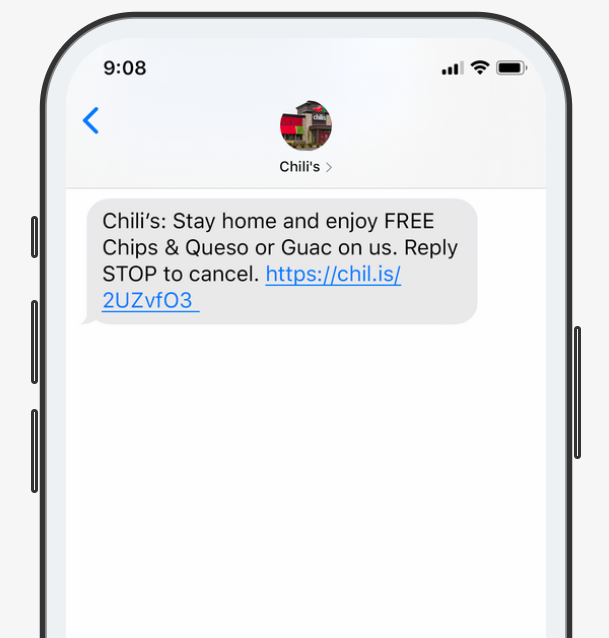
Through this, the brand does a few things:
- Continues to serve and satisfy customers
- Frames Chili’s as a socially conscious and responsible brand
- Provides incentives for new potential subscribers
It is a solid message strategy all around.
2. Carl’s Jr
Carl’s Jr is a quick-service restaurant with over 1,300 locations around the world. With a number of food options, Carl’s Jr. understood that it needed to find a way to reach hungry and impatient consumers before they went elsewhere.
So, what is the best way to compete with other QSRs (Quick Service Restaurants) during the hot summer months?
The answer is SMS marketing.
The brand created a limited-time offer for a combo of a burger and fries for only $2.99 instead of the usual $6.00.

In almost no time, 20% of its opted-in customers redeemed their unique codes at restaurants. As a result, for every $1 spent on the SMS campaign, the brand made $14 in new sales. Obviously, short, time-sensitive offers deliver serious results.
3. Pizza Hut
During 15 months, Pizza Hut set up geofence locations within a half-mile radius of each of their 340 locations.
What does that mean?
Simply, it means that when customers were within a half-mile of any Pizza Hut location, they’d receive an SMS promotion on their phone. Once Pizza Hut received permission, they could track that customer’s location and text them messages based on their location. Pretty cool, huh?
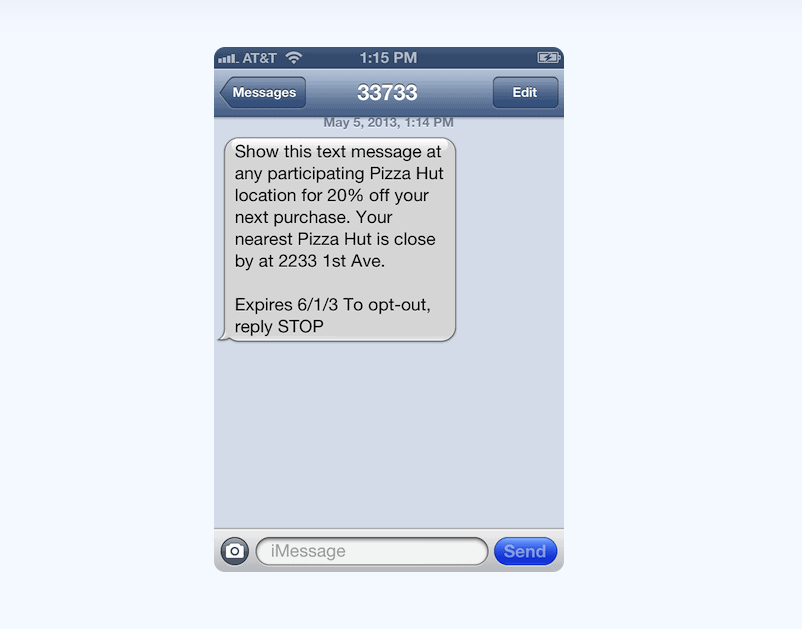
As a result, Pizza Hut found it was on average 142% more effective in increasing incremental sales than other channels, and 4.4 times more efficient than TV ads, and 2.6 times more efficient than online ads.
4. Bulmers Irish Cider
Also with an SMS geofence, Bulmers Irish Cider realized impressive results. The brand ran an SMS geofence campaign within a half-mile radius of over 1,000 pubs in the UK that served their cider. The campaign was targeted at males between the ages of 18 and 34. Once customers were within that radius, they received a text message pointing them in the direction of their next cider.
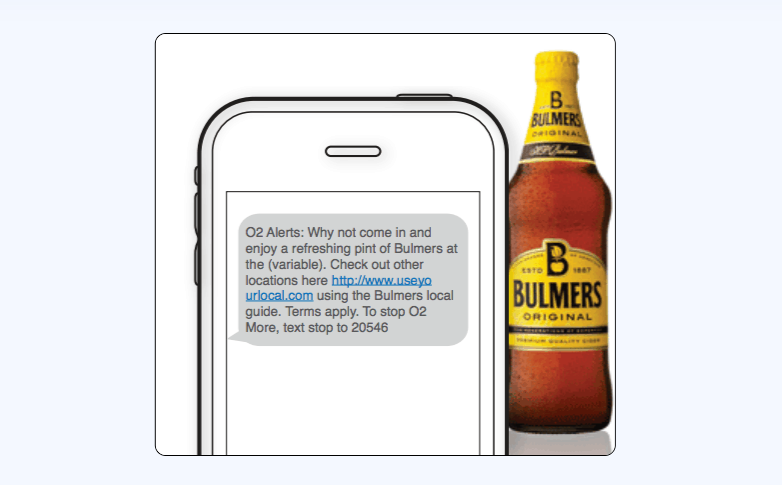
Over 4 weeks, they sent out 77,000 text messages, with 50% of the recipients clicking on the link in the text message. More importantly, 25% of recipients bought a cider from the suggested pub, and 53% bought a Bulmers from another pub recommended by clicking on the link in the text message. So, in total, that’s almost a 75% conversion rate!
5. Dunkin’ Donuts
Dunkin’ Donuts launched an SMS marketing campaign geared towards young adults in the Boston area that increased in-store traffic by 21%.
The brand had a local radio DJ promote the campaign on-air and ran mobile internet ads encouraging people to opt-in. As a result, 7,500 customers opted in to receive its text message promotions.
After the first SMS promotion, the brand saw the following results:
- 17% of recipients forwarded or showed the promotion to a friend
- 35% of recipients considered themselves more likely to buy coffee and lattes from the brand in the future
- 21% increase in-store traffic
This shows how a successful SMS marketing campaign has the ability to drive significant results.
Related topic: Top 20 SMS Marketing Examples/Case Studies to Inspire You
6 SMS marketing ideas for restaurants
Try the 6 following ideas to spice up your restaurant SMS marketing strategy!
1. Promote deliveries
In the COVID-19 pandemic, reduced foot traffic and guest capacity have led many restaurants to offer delivery for the first time. SMS marketing can let your customers know they can now order food and where to find you online.
Moreover, effective use of SMS marketing significantly contributes to a smooth delivery experience. Integrate messages texting with your ordering system to send automated text messages to customers and drivers.
Some restaurants even offer customers the ability to order via text messages. For instance, Domino’s customers can easily make repeat orders by sending an emoji to their business text number.
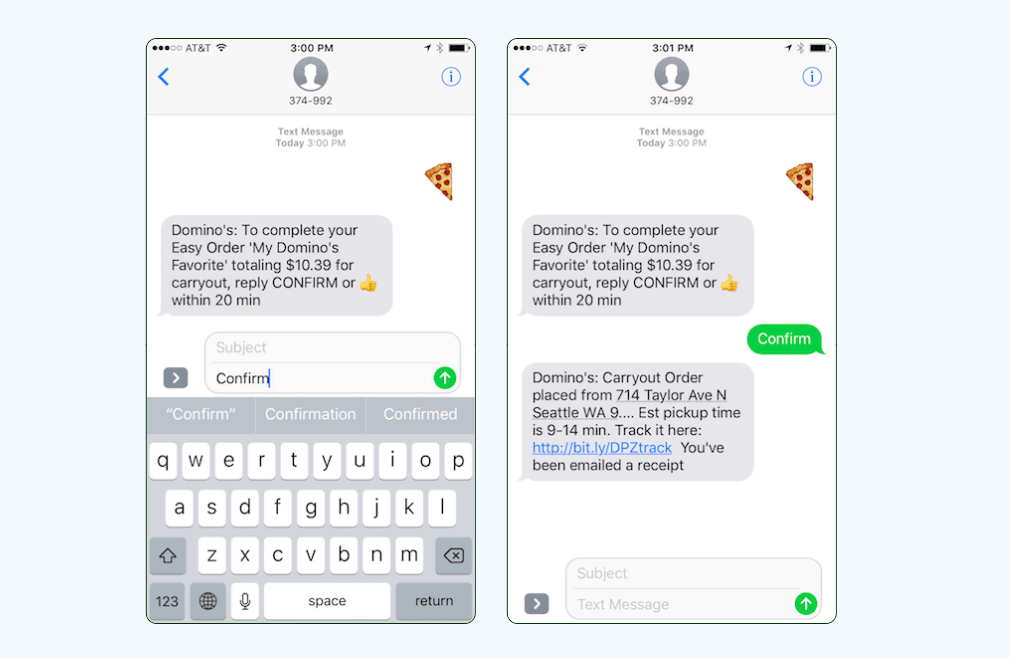
2. Offer exclusive deals to loyal customers
Encouraging repeat customers to subscribe to your SMS marketing allows you to show your appreciation and provide them with VIP treatment. A customer loyalty program increases repeat guests, which has a major impact on your bottom line.
Members-only events to your trial menu changes or celebrate holidays make customers feel special as well as offer your business a valuable benefit. Your text subscribers are often your most loyal customers, making them the ideal focus group to test changes to your restaurant.
3. Announce upcoming events
SMS marketing is an excellent way to announce upcoming events, offers, and special menus you’re running. Allowing your subscribers to book events earlier can reward customer loyalty and give guests more reasons to sign up.
Olive Garden - a US restaurant chain - uses SMS to enable early booking of holiday events like Valentine’s Day or Mother’s Day before the rush.
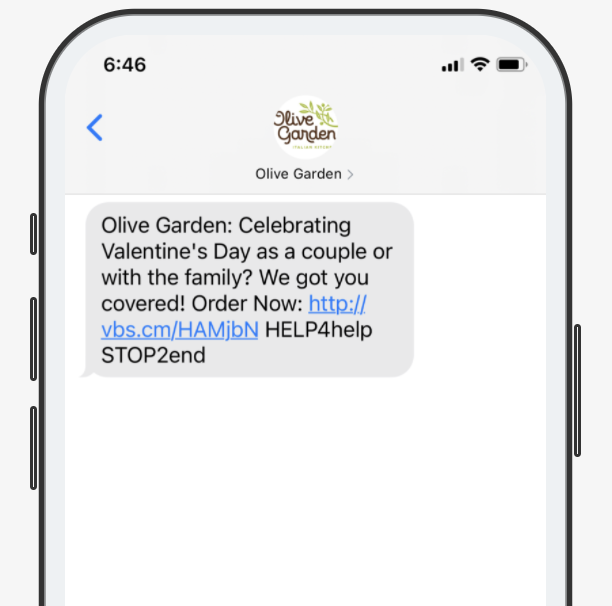
In addition to promoting events and offers, you can use SMS to share the latest news about your restaurant. For instance, announcing new items on your menu, a new chef, or a new partnership with a local food or drinks producer.
4. Send SMS reservations
Using SMS marketing for reservations offers many benefits, especially for restaurants that have to reduce guest capacity due to the pandemic.
Besides making it more simple for customers to book a table without waiting for someone to pick it up in a busy period, SMS marketing can also be used to send out available booking times. This reduces the frustration of trying to book a table at a popular restaurant with limited capacity.
It also allows you to cut down on vacant tables due to canceled or missed bookings, as you can text subscribers with the available time at a last-minute discount.
5. Collect customer feedback
Text messages can not only be used for marketing and advertising purposes but also used as a survey tool. You can have customers tell you what additions or changes they would like in your restaurant in terms of the food, service, and ambiance.
Asking for feedback makes your subscribers feel like a part of your restaurant and encourages them to continue their patronage. Let’s see how Round Table Pizza did to collect customer feedback via text messages!
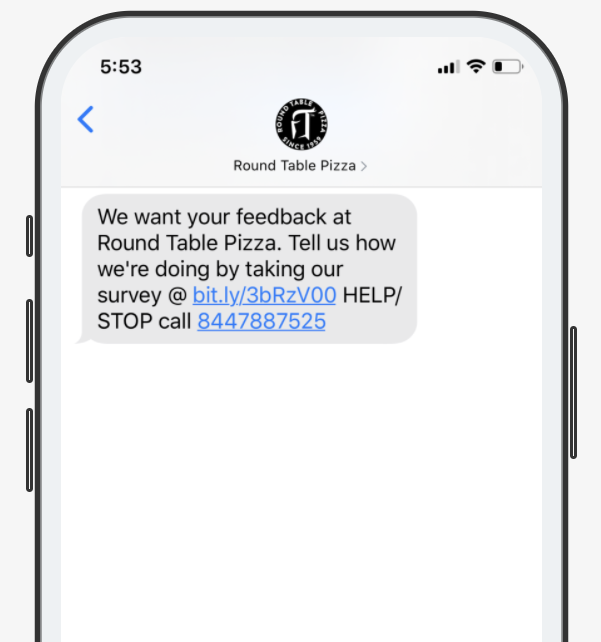
6. Send thank you messages
A thoughtful, warm thank you message can put a nice finishing touch on your customers’ evening, ensuring that they feel appreciated and welcome to return soon. Dining out is not as simple and convenient as it used to be, making it much more necessary than ever to show your gratitude to regular customers.
Thank you messages can also help remind guests to leave a positive review online.
7 useful SMS marketing templates for restaurants
Not sure what to say? The following templates will give you some inspiration to create text messages that fit your restaurant’s personality. Don’t forget to customize them before sending!
1. Delivery promotion
Hi {first_name},
Not going out? We are now offering online delivery orders at {link}! Reply MENU to this text now to check out this week’s specials
2. Discount offer
Hi {first_name},
We are open for business again! To celebrate, we send you a 30% discount on a meal for two. This offer is valid for 7 days. Show this text to your server when you visit to redeem it.
3. Event invitation
Hi {first_name},
We are hosting a wine-tasting evening on Friday, Nov 11th, at 6 p.m. If you’d like to join us, please book at {link} or reply INFO to this text to find out more about this event.
4. Table reservation
Hi {first_name},
We have booked your table for Friday, Nov 11th, at 8 p.m, and we’re looking forward to seeing you! If you’d like to rearrange your booking, please reply TIMES to this text to check our booking availability. To cancel your table, text CANCEL.
5. Restaurant polls
{restaurant_name} What is your favorite dish?
A. dish 1
B. dish 2
C. dish 3
Submit your vote by Friday and win a $20 coupon.
6. Sweepstakes
Hi {first_name},
Fill out our survey at {link} and win a free dinner for two. Winners will be notified on Friday, Nov 11th at 8 p.m. Good luck, {restaurant_name}
7. Thank you message
Hi {first_name},
Thanks for dining with us, we hope you come back soon! We would love to hear feedback on your experience. You can reply to this text with a rating from 1 to 10 or leave us a review at {link}.
Read more: 28+ SMS Templates for Marketing That You Can Use Immediately
8 practical tips to boost your SMS marketing for restaurants
When it comes to running a successful SMS marketing campaign for your restaurant, here are some of our key recommendations:
1. Ensure that people opt-in to receive your messages
The first and foremost tip you need to know to avoid hefty penalties is that SMS recipients must opt-in to receive texts from you.
Just because someone has signed up for your email list or has purchased from you doesn’t mean you have permission to send text messages to their phone. Thus, to air on the side of caution, you should keep your email and SMS signup methods separate.
Email newsletters are often opted-in by way of a subscription form on a restaurant’s website. Meanwhile, SMS marketing is a little bit different. An SMS recipient will opt-in by texting an SMS keyword to a five- or six-digit number (a shortcode). Long numbers, which include mobile phone numbers, can also be used for inbound messaging.
For instance, Applebee’s used a shortcode opt-in strategy to collect new subscribers and achieved amazing results. Their guests could simply text a shortcode to opt-in and receive special offers instantly. This strategy is also applied by many other well-known brands.
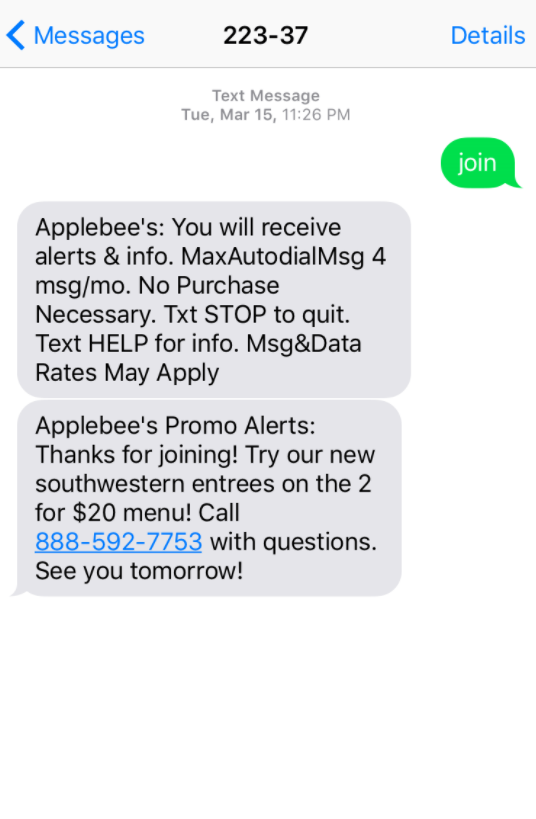
2. Make sure your message is worth it
To be successful, your text message should have a combination of value, exclusivity, and clarity. With every SMS marketing campaign, it is vital to ask the following questions:
- What value can guests get from you?
- How exclusive is it?
- Is the message clear?
Once you run more SMS campaigns, you’ll start to see trends emerge that help you refine messaging further.
3. Stay relevant and engaging
Staying relevant and creating content that subscribers enjoy will help boost engagement. You can accomplish this by providing real-time promotions and information that are triggered by your guests’ recent behavior or transactions.
You can further improve your effort by partnering with location data to offer tailored deals and promotions. And, of course, don’t hesitate to show off your brand personality with fun texts and emojis to make your SMS campaigns even more interesting!
4. Include concise, compelling CTA (calls to action)
If your recipients are not told exactly what to do, chances are, they don’t do anything. Therefore, if you want to create an effective SMS marketing campaign, make sure to include clear CTAs that guide the recipient to the next step.
Effective CTAs are brief and to-the-point. One of the most common CTAs in SMS marketing is “Reply X to X.” This and all other CTA variants help guide your recipients to the next sequential step to make a purchase.
Below are some CTAs that help you get more traffic through your doors:
- “Reply to this message”
- “Come in today”
- “Visit this website”
- “Use this coupon code”
- “Order online now”
- “Show this message to your server”
Think you can do us one better? Go for it!
Write your own custom CTAs and include one in each SMS message you send.
5. Use power words to evoke emotions
Your text messages and advertisements should reflect the emotion you’re trying to trigger. For instance, the words “VIP,” “exclusive,” and “revolution” that Papa Murphy’s used below can trigger feelings of greed, convincing readers that they are part of a secret, free cheesy bread club.

What other words can help you trigger particular emotions? The list is limitless, but the bottom line is this: pick words that are relevant to your brand. Just like a vegan cafe wouldn’t go with the same phrases to attract customers as a five-star restaurant, neither should you.
While Domino’s uses emojis, most restaurants choose powerful language to make their point. Chick-fil-a is one of the restaurants that prove the power of word-choice on SMS marketing campaigns. The brand used witty misspellings - “Chikin” instead of chicken - to grab their recipient’s attention. As a result, the brand saw a 65.3% spike in new website visits via social shares, including SMS messaging.
6. Personalize where possible
One of the advantages of text marketing is that it can give you a chance to create personalized content. Also, this goes a long way in increasing engagement and interest in your campaigns.
Leverage guest data to deliver personalized messages about purchase behavior, the last visit, and the time of day visited for maximum interest. For instance, do you have a guest that frequently orders a hamburger for lunch on Fridays? Hit them with a hamburger and latte combo an hour before lunchtime to increase the value of their visit.
7. Optimize frequency
Getting the frequency of SMS marketing campaigns right is often challenging. Too much, and you risk being ignored. Too little, and it is easy for customers to forget. The general rule of thumb is to stay consistent without going overboard.
Opt for 2-4 messages per month at the most, and try to deliver at consistent times when you see the most engagement. Read through SMS Marketing Rules/Laws to ensure that you’re compliant with your campaigns.
8. Integrate SMS marketing with other marketing channels
It’s a good idea to include your text messages in the bucket of marketing channels you target to promote.
There is a better chance of moving guests through the leads or sales funnel if they see your messages on various platforms. It can establish a good brand recall and boost the likelihood of guests taking action.
For instance, consider creating automation workflows, including both SMS and email marketing, to optimize your sales.
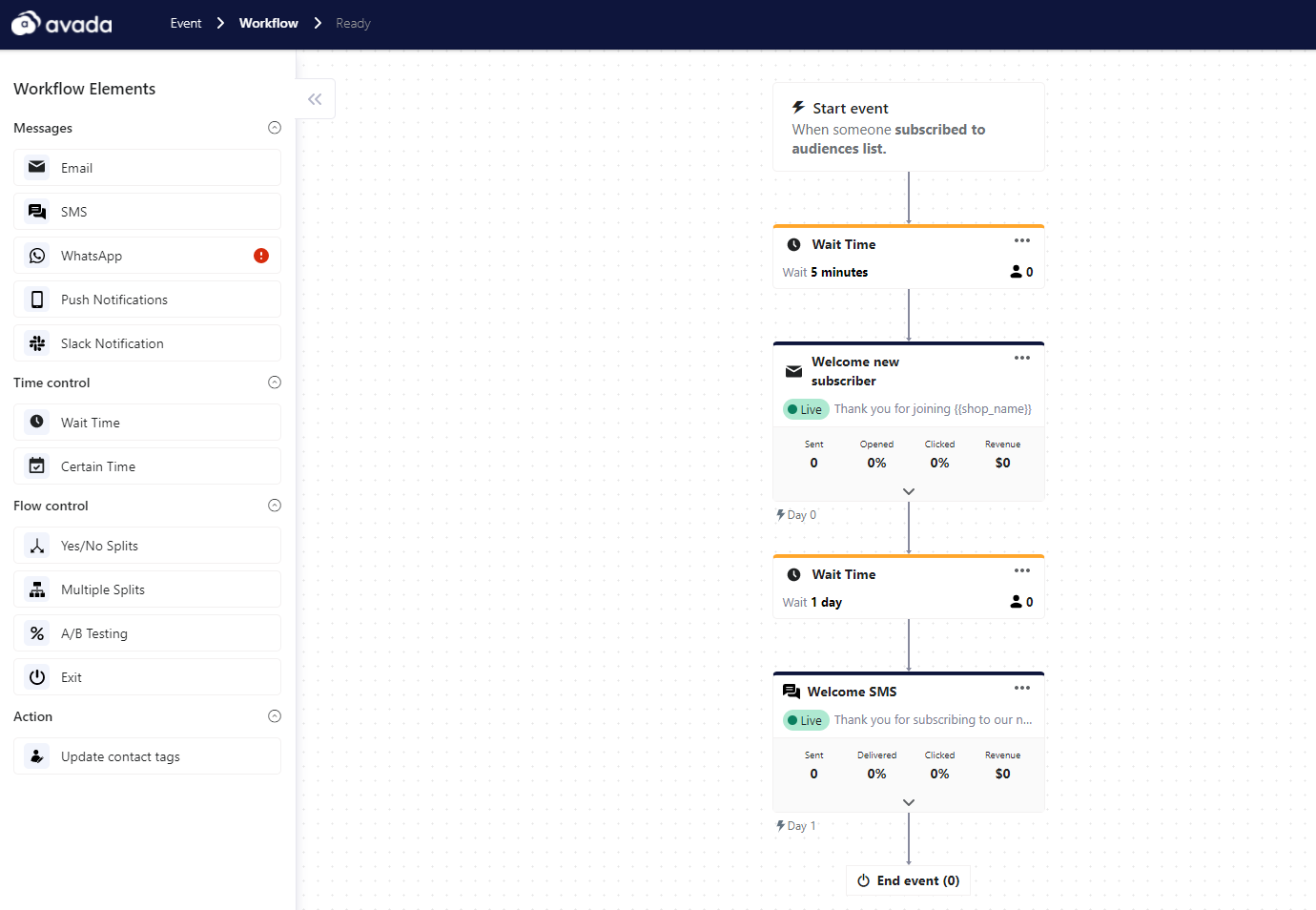
AVADA Commerce can help you do that immediately. For more information, please head to our guide on How to Combine Email and SMS in Automation.
DISCOVER AVADA SMS & EMAIL COMBINATION
The bottom line
SMS marketing is a robust tool for restaurants to reach their guests and approach real-time offers and essential information when used correctly. When implemented as a part of a multi-channel marketing strategy, SMS marketing can help restaurants create and strengthen guest relationships and build loyalty.
We hope this ultimate SMS marketing guide for restaurants can help you a lot. Don’t hesitate to contact us if you have any concerns about this topic. Thanks for reading, and happy sending!
New Posts






